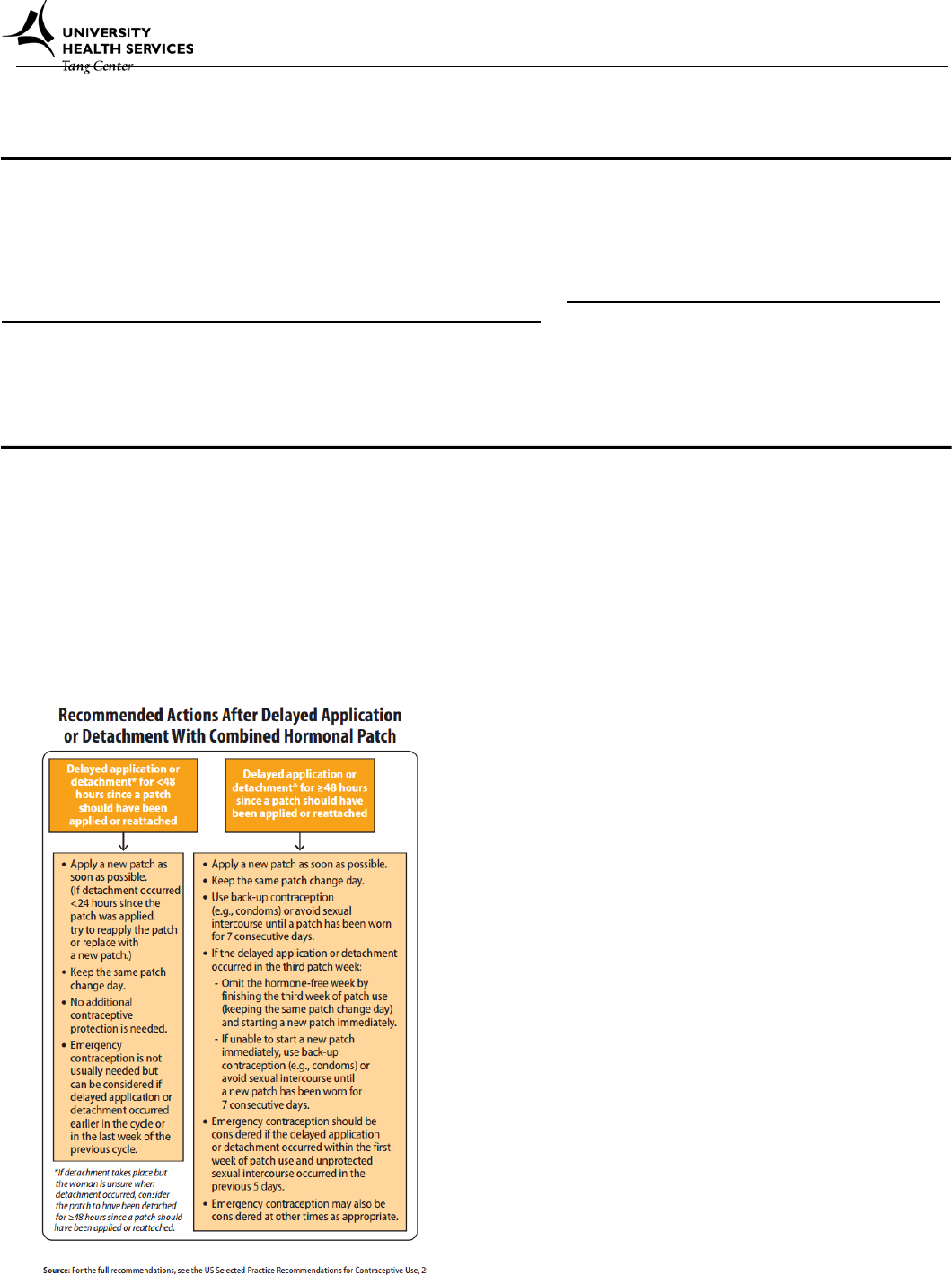
University of California, Berkeley
2222 Bancroft Way
Berkeley, CA 94720
S:\Handouts\Clinical\PatchContraceptive.doc
Page 1 of 2
“THE PATCH”
XULANE
Background Information
“The Patch”, is a thin, beige, flexible, square patch, which is applied to the skin once per week. The brand name Ortho
Evra isn’t being produced anymore so ask for the generic Xulane. Low-doses of estrogen and progestin (similar to
hormones found naturally in the people with ovaries and hormones in combined oral contraceptive pills) are
continuously released over a 1-week period. These hormones, when provided in adequate amounts, prevent
ovulation—if there is no egg to meet the sperm, pregnancy cannot occur. In addition they have a reversible effect on
cervical mucous and uterine lining, which also discourages pregnancy. The average effectiveness of the patch is 91%.
The effectiveness can be increased with consistent and correct use.
IF YOU TAKE ELLA FOR EMERGENCY CONTRACEPTION WAIT 5 DAYS TO START THE PATCH. THE PATCH
WILL NOT BE EFFECTIVE FOR 7 DAYS AFTER STARTING IT. If you have taken Plan B for emergency
contraception, it does not interact with the patch like Ella, so you can go ahead and start the patch following the
instructions below.
Instructions for Use
The Patch may be applied to buttocks, abdomen, upper back, or on the outer upper arms. Do not apply the Patch to
your breasts. Always apply the Patch to a clean, dry, non-infected or irritated skin surface. Apply a new patch every 7
days. There are two recommended ways to start the Patch:
§
Quick start: apply the patch the first day you pick up your prescription. Unless this is within five days of the start
of your menstrual period, use a back-up method (i.e. condoms) for 7 days
§
Start the patch within the first 5 days of the onset of your menstrual period, no additional contraception is
needed
§
After 3 weekly patches, the third Patch should be removed for 1 week to allow for withdrawal bleeding (menses)
§
If you stop using the Patch and do not want to become pregnant, start using another contraceptive immediately,
or abstain from vaginal sex. Your ability to become pregnant returns right away after you stop the patch.

THE PATCH (XULANE) CONTINUED
S:\Handouts\Clinical\PatchContraceptive.doc
01/2020
Answers to the most common questions about the Patch
What should I do if I am spotting or having my period (withdrawal bleeding) when I don’t expect it?
§ Keep using the Patch. Consult a clinic Advice Nurse 643-7197.
If I miss a period (withdrawal bleeding) but I have used the Patch correctly, do I need to worry that I may be
pregnant?
§ Consult a clinic Advice Nurse 643-7197.
Note: Decreased effectiveness has been noted in women at or above 198 lbs.
Temporary Minor Discomforts
Some people experience a variety of minor discomforts when starting combined contraceptives, including
the Patch. Some of these symptoms may be nausea, breakthrough bleeding, breast enlargement or
tenderness, slight weight gain, mood changes, and changes in libido. Most of these symptoms will
disappear within the first three months of using the Patch. Patch-related problems include skin irritation at
the site of Patch application. If these symptoms persist, call a clinic Advice Nurse at 643-7197.
The Patch Danger Signs
Abdominal pain (severe)
Chest pain (severe)/shortness of breath/coughing up blood
Headaches (severe)/dizziness/weakness/numbness
Eye problems (vision loss or blurring)/speech problems
Severe leg pain of calf or thigh
If you develop any of these symptoms:
§ Call or immediately come to Urgent
Care, 642-3188, or other emergency
medical facility
§ Call 911 for ambulance in extreme
emergency
Major Patch Complications
The most serious risks of combined contraceptives, including the Patch, are the potential for cardiovascular
complications: blood clots, stroke, hypertension, or heart attack. These side-effects are extremely rare and
occur most often in people who smoke, who are over age 35, who have other health problems like
hypertension, diabetes, heart disease, vascular disease, or blood clots, and those who have a family history
of diabetes or heart attack under the age of 50. If you smoke, you may have an increased risk for
developing major complications. Young, healthy, non-smoking people can use the Patch with very little risk
of developing serious complications. Learn the Patch Danger Signs listed above.
The Patch, Emergency Contraception (EC) and Other Drugs
If you need to use emergency contraception while using patches (had intercourse and didn’t use a backup
method for the first 7 days or you forgot to change your patch when you were supposed to), use Plan B or
the generic equivalent (levonoregstrel) rather than ELLA (ullipristal) because ELLA can decrease the
effectiveness of your patches and the patches reduce the effectiveness of ELLA.
The Patch may have adverse interactions with some other medications. In some cases contraceptive
effectiveness is lowered. In a few cases another drug may reach a toxic level in combination with the
Patch. Be sure to inform your clinician and pharmacist at each visit of any medications, including non-
prescription drugs, which you are taking. Always advise any clinician that you see for any medical
problem, especially if admitted to a hospital or before surgery, that you are using the Patch.
Sexually Transmitted Diseases and Preventive Care
Even though you are using the Patch, seriously consider using condoms as well in order to protect each other
from sexually transmitted diseases (STD’s) eg, herpes, chlamydia, syphilis, HIV, etc. Pap testing is
recommended starting at age 21. See the UHS website for screening recommendations, self-directed testing
and scheduling an appointment:
http://uhs.berkeley.edu/medical/primary-care/sexual-health-care-tang
Check our Website: uhs.berkeley.edu to learn more about this and other medical concerns. For
Appointments: etang.berkeley.edu or call 510-642-2000 For Advice:call 510-643-7197
